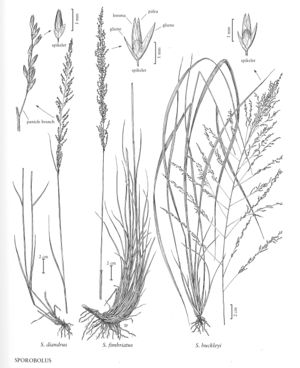Sporobolus fimbriatus
Plants perennial; rhizomatous. Culms 30-120(160) cm. Sheaths rounded and papery below; ligules 0.1-0.3 mm; blades 10-30 cm long, 2-4(5) mm wide, not obviously distichous, flat, becoming folded, pilose abaxially, tapering to the slender apices. Panicles 15-50 cm long, 2.4-8 cm wide, somewhat contracted to rather lax and open; primary branches appressed or ascending, spreading to 60°from the rachis; spikelet-bearing to the base or without spikelets on the lower 1/4, lower branches mostly 2-9 cm, longer than the internodes; pedicels 0.7-3 mm. Spikelets 1.4-2.2 mm, plumbeous to greenish. Glumes unequal, linear-lanceolate to ovate, membranous; lower glumes (0.4)0.6-1.2(1.5) mm, without midveins, acuminate; upper glumes (0.9)1.4-2 mm, 2/3 to as long as the spikelet, faintly 1-veined, acute; lemmas (1.4)1.8-2.2 mm, narrowly ovate, glabrous, 1-veined, acute; paleas (1.2)1.6-2 mm, ovate; anthers 3, 09-1.2 mm. Fruits 0.6-1 mm, quadrangular, laterally compressed, whitish-brown, truncate. 2n = unknown.
Discussion
Sporobolus fimbriatus is an African species that has only been found in waste areas near the sites of old wool mills in Berkeley and Florence counties, South Carolina.
Selected References
None.
